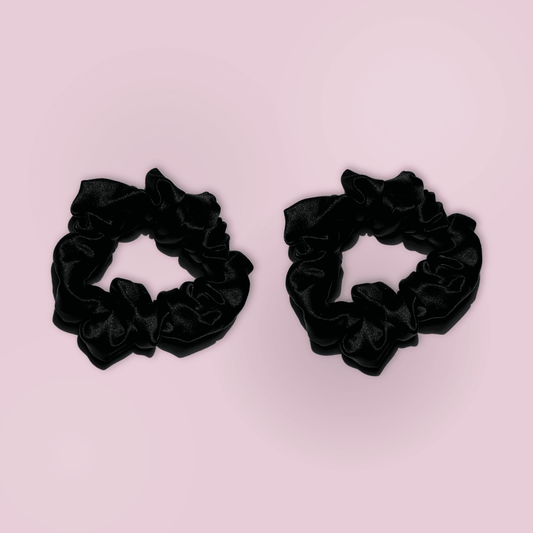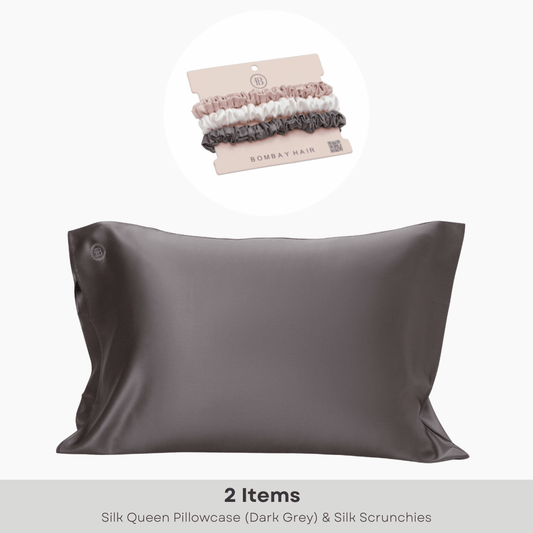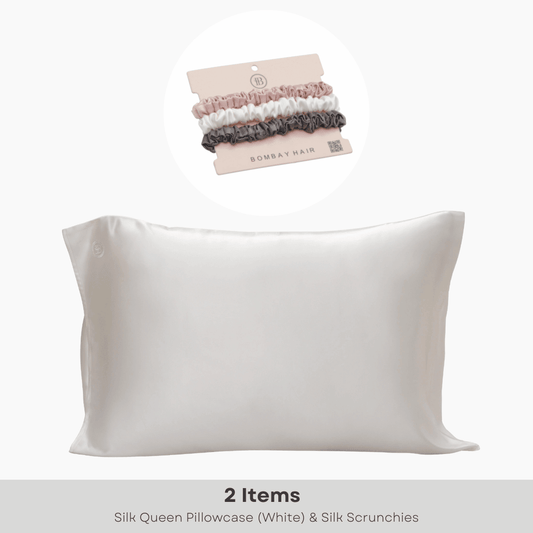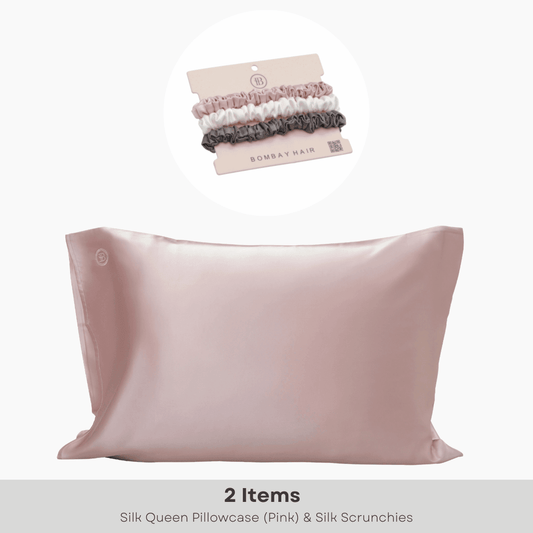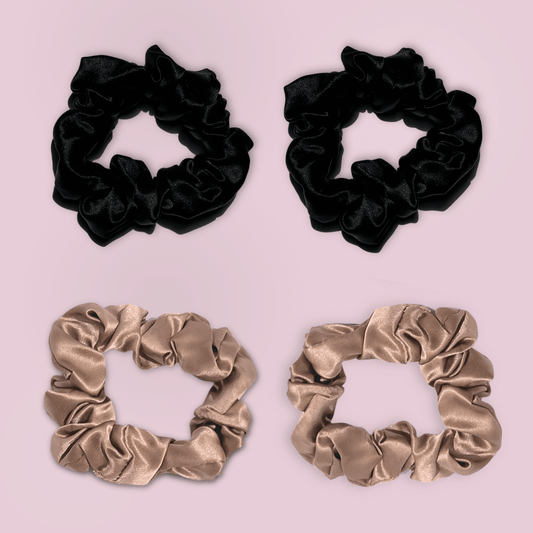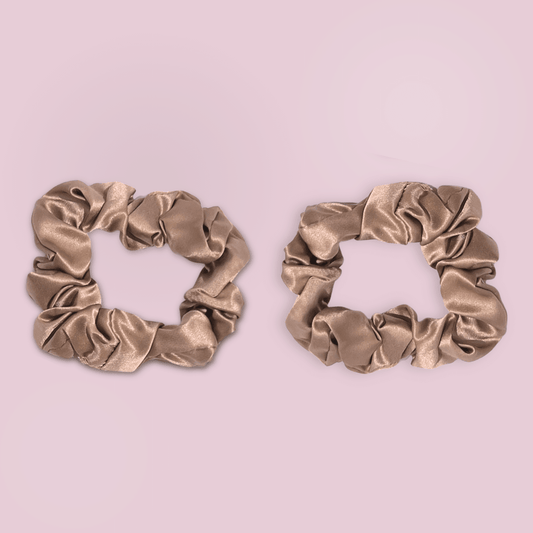Hair Clips / Silk Hair Ties
Benefits and Taking Care of Your Silk Hair Ties
What Are Silk Hair Ties?
Silk hair ties have a rich history that dates back to the ancient civilizations of China, where silk was first discovered and utilized. Revered for its lustrous sheen and luxurious feel, silk was carefully woven into various accessories, including hair ties, used by royalty and nobility. Over the centuries, as silk production spread across the globe, these hair ties became increasingly popular for their ability to secure hair without causing breakage or damage.
In the present day, silk hair ties continue to be a favored choice for many, owing to their exceptional gentleness on hair. They reduce friction, prevent hair creasing, and contribute to maintaining hair health - a significant upgrade from traditional elastic hair ties. Furthermore, they add a touch of elegance and sophistication to any hairstyle, making them a versatile accessory in any beauty arsenal.
Benefits of Silk Hair Ties
One of the most significant benefits of silk hair ties is their ability to maintain hair health. Silk's smooth texture reduces hair friction, minimizing the risk of breakage, split ends, and other forms of hair damage. Unlike traditional hair ties, they prevent creases and kinks in the hair, even when worn for extended periods.
Silk hair ties are also known for their hypoallergenic properties. They don't attract dust or allergens, making them an ideal choice for those with sensitive scalps or allergies.
Moreover, they help to retain the moisture in your hair, thereby preventing dryness and contributing to overall hair health. This is particularly beneficial for those with curly or textured hair, which tends to be more prone to dryness.
Lastly, the aesthetic appeal of silk hair ties cannot be overlooked. They lend a touch of elegance and sophistication to any hairstyle, suitable for both casual and formal occasions.
Selecting the Right Silk Hair Tie
Selecting the right silk tie involves several considerations. Firstly, identify your hair type - thin, thick, wavy, straight, curly, or textured. For example, Mulberry and Charmeuse silk ties typically work best for fine to medium hair due to their smooth texture. Thicker hair might find Tussah silk ties more effective due to their slightly coarser texture.
Next, consider your lifestyle and usage. If you’re seeking elegant, high-end hair ties for special occasions, Mulberry or Charmeuse silk may be the ideal choices. For everyday use, Habotai silk ties, while less durable, are more affordable and still offer the benefits of silk.
Lastly, consider your aesthetic preferences. Silk hair ties come in a variety of colors, patterns, and designs. Choose a style that complements your personal taste and wardrobe. Ultimately, the best silk tie is one that combines functionality with personal style. Remember, a good silk tie not only looks great but also helps maintain hair health.
Caring for Silk Hair Ties
Taking care of silk hair ties is important to ensure their longevity and maintain their gentle and hair-friendly qualities.
Washing Silk Hair Ties
Silk hair ties should be washed gently by hand, using cold water and a mild detergent specifically designed for silk. Avoid using harsh chemicals or bleach, as these can damage the silk fibers and affect the hair tie's quality and lifespan. Start by filling a basin with cold water and adding a small amount of silk-friendly detergent. Submerge the tie in the water, gently agitating it to remove any dirt or residue. Rinse thoroughly under cold running water until all the soap is removed.
Storing Silk Hair Ties
Proper storage of silk hair ties is crucial to maintain their longevity and quality. After washing and drying, store your silk hair ties in a cool, dry place away from direct sunlight, as prolonged exposure to sunlight can cause the silk to fade. Avoid keeping them in damp or humid areas, as this can lead to the growth of mold or mildew on the silk. A jewelry box or a special compartment in your drawer could be a perfect place to store them. If you're traveling, consider using a small silk pouch to carry your hair ties, as this will protect them from damage and dirt. It's also a good idea to untie any knots before storage to prevent the silk from stretching and deforming.
Maintaining Elasticity
Maintaining the elasticity of your silk hair ties is essential to ensure they continue to hold your hair effectively. Overstretching can lead to a loss of elastic feature and shorten their lifespan. To avoid this, refrain from pulling the ties too tightly when securing your hair. It's also a good idea to rotate between different hair ties to prevent overuse of one. If you notice a silk tie is losing its elastic feature, give it a 'rest' by not using it for a few days. This allows the material time to regain its natural elastic feature. Heat can cause silk to lose its elastic capacity, so avoid exposing your hair ties to high temperatures, such as hot water, hair dryers, or direct sunlight.
Tips for Longevity
For optimal longevity of your silk hair ties, here are some additional tips:
- Avoid harsh environments: Silk is a delicate material that can be damaged by harsh environments such as extreme temperatures, rough handling, or contact with sharp objects. Try to keep your silk hair ties in a safe, protected environment as much as possible.
- Address stains immediately: If your silk hair tie gets a stain, clean it immediately using a detergent. This prevents the stain from setting into the silk fibers, which can be difficult to remove later.
- Use a gentle detergent:Always use a mild detergent when washing silk, as harsh detergents can damage the silk fibers.
- Avoid wringing or twisting:Silk is very sensitive to water and can lose its shape and strength when wet. When you wash your silk hair ties, avoid wringing or twisting them to remove water. Instead, gently press the water out and lay them flat to dry.
- Regular inspection: Regularly inspect your silk hair ties for any signs of wear and tear. If you notice any loose threads, snags, or thinning of the material, it's best to replace the hair tie to prevent further damage.
- Avoid overuse: Silk hair ties can lose their elastic capacity with constant use. Rotate between different hair ties to prolong their lifespan.
By following these tips, you can extend the lifespan of your silk hair ties, ensuring they stay beautiful and you wear it for a long time.
 USD
USD
 CAD
CAD


